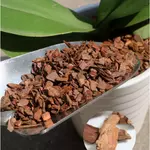The Calathea Fasciata is a prominent member of the Calathea variant that emerges from the dense rainforests of Brazil. The plant is a massive attraction with its thick and luscious leaves, which have dark and light veins on the leaves’ top and beautiful purple undersides. Calathea Fasciata has a striking appearance and will illuminate your space, whether it’s your garden, a living room, or a balcony.
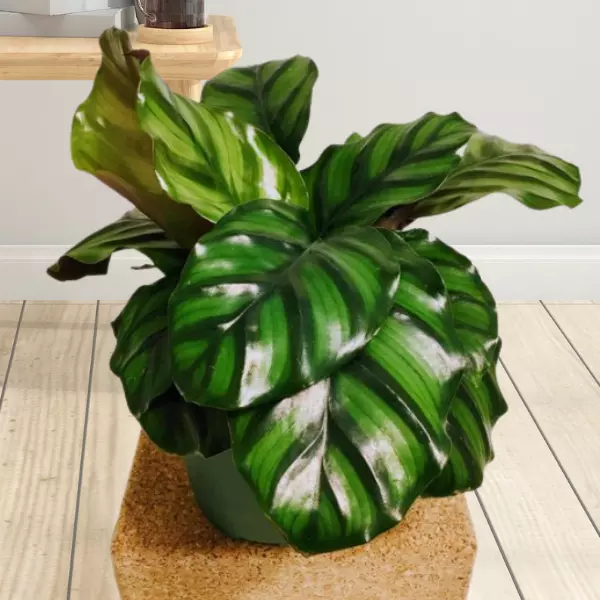
Calathea Fasciata Borrusica is the most common cultivar of the plant. People mistakenly confuse the plant with Orbifolia; however, both plant leaves’ sizes and stripes’ color are distinctively different. Orbifolia exhibits green colored leaves contrasting light and dark green stripes whereas Fasciata features dark green foliage .
Prominent Family Members: Calathea Makoyana, Calathea Leopardina, Calathea Crocata, Calathea Roseopicta, Calathea Picturata, Calathea Lutea, Calathea Freddie
Essential Products
How do you care for Calathea Fasciata?
The Calatheas are usually demanding in nature and require extra attention from gardeners. However, Calathea Fasciata is different and is an easy to care plant. You shall provide it with a suitable watering scheme and optimum light to flourish. The plant shall require a humid environment, well-draining soil, and warmer temperatures to produce the hallmark mesmerizing leaves.
This article will share essential information about the Calathea Fasciata plant to keep this plant healthy and problem free. Let us dig in deep for all the requirements you need to take care of.

Bringing the plant to home
Before adding the Calathea Fasciata to your houseplants collection, there are some critical points to ponder. Pests and infestations occasionally attack the Calathea species, and you shall carefully inspect your new Calathea Fasciata for any sign of disease. The leaves of Fasciata are large and round and make a perfect place for pests to hide underneath them. Therefore, particularly look on the underside of the leaves for any sign of pests’ growth. As a precautionary measure, put the plant in quarantine for two weeks. If there is no alarming observation during the two weeks, shift the plant to its permanent location.
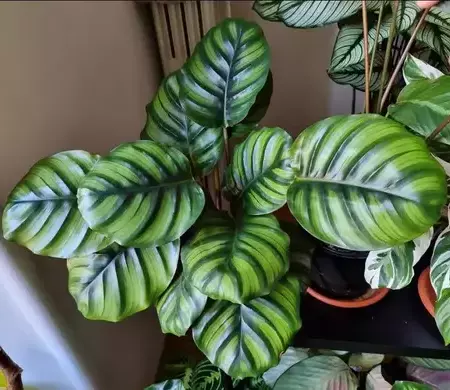
Calathea Fasciata

Sunlight requirement for Calathea Fasciata
For the best growth, the plant requires bright, indirect sunlight. The fact that the plant can tolerate low light levels makes it a perfect choice as an indoor plant. If you plan to grow the Fasciata outdoors, plant it under the shade of large trees.
Moreover, direct sunlight exposure for an extended duration will harm the plant and burn the leaves. The fading color and burning of leaves will abolish the plant’s beauty.
The best position indoors for your Calathea shall be a few feet away from sunlight receiving light, ensuring direct sunlight does not reach the plant leaves. Do not forget to rotate the plant after one week, so all sides of the plant get an equal amount of sunlight. Your plant will exhibit homogenous growth and stunning leaves in all directions.

Temperature and Humidity
The plant is a humidity lover and will display gorgeous foliage if kept under more than 50% humidity levels. The leaves’ edges will become brown if adequate humidity is unavailable to the plant.
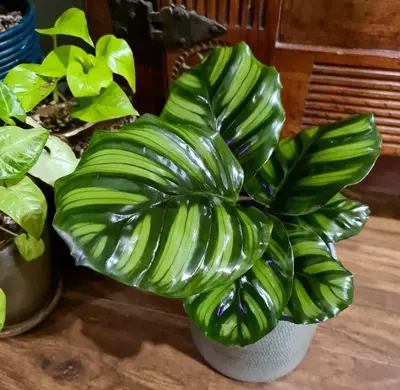
The indoor humidity levels can go low because of internal heating in winters and air conditioning in summer. There are several ways to increase humidity indoors.
The Calatheas originate from the warmer temperatures of Amazon, and Calathea Fasciata grows well in the temperature range of 50° to 80°F. The plant will suffer if the temperature drops below 50°F, and you shall bring the plant indoors in such scenarios.

How often should I water my Calathea Fasciata?
The Calathea Fasciata loves to sit in damp soil; therefore plant prefers a frequent watering schedule. In addition, the soil shall be slightly moist instead of being over wet or soggy. Work out the watering plan by frequently checking the soil moisture level. Only water the Calathea Fasciata plant if you feel the top two-inch of the soil is dry. Ensure to water deeply and let the excess water drains through drainage holes.
Calathea Fasciata plant doesnt like to dry out completely between watering. They prefer moist soil but not the soggy soil. Moreover,overwatering is harmful to plants’ health as waterlogged soil will invite fungal attacks and may result in the rotting of roots.
Furthermore, Calathea Fasciata plants are impacted by the high amount of minerals. Therefore, if your tap water is high in minerals, use rainwater or distilled/filtered water to meet the plant’s watering needs.

Soil Requirement for Calathea Fasciata
The plant lives well in porous soil, which is moisture-retaining and well-draining. The perfect soil for Calathea Fasciata shall include constituents like peat moss or coconut coir to make it moisture retaining. Similarly, sand or perlite shall be a part to improve the draining capability of the soil. Finally, orchid bark or organic matter will increase the nutrient level and improve the aeration quality.
You can make an ideal mix for your Calathea Fasciata by mixing the following ingredients;
- 25% peat
- 25% compost/potting mix
- 20% perlite
- 20% Orchid Bark
- 10% charcoal
However, if you intend to purchase ready-made soil mix, a commercially available potting mix African Violet potting mix or Fox Farm Ocean potting mix is best suited for Calathea Fasciata.
Related Products
Products | Name | Check Price |
Organic Perlite for Plants | ||
WONDER SOIL Organic | ||
Orchid Potting Bark Mulch |

Fasciata plant Grooming and Pruning
Calathea Fasciata does not have any specific pruning requirement. The only maintenance the plant will be requiring is the removal of dead or diseased leaves. Always use clean and sterilized tools to carry out the pruning to stop the spreading of plants disease.
The Fasciata leaves are its main attraction and cleaning them frequently will add to the plant vigor. Cleaning with damp cloth not only removes the dust but also takes care of the pests and thus decreases the chances of infestation attack.

Fertilizing Fasciata plant
Plant parents adore Calathea Fasciata due to its bright foliage. The plant leaves will be more vibrant if you fertilize the plant every four to six weeks. We recommend fertilizing the Calathea Fasciata only in the growing season, which lasts from spring to summer.
Fertilizing in dormant winter will not help rather negatively impact the plant. Excessive minerals in the soil can damage the plant roots. The plant’s leaves will turn brown if exposed to more than required fertilization. In case of such symptoms, carry out soil flushing to remove the extra minerals. For flushing, place the plant under running water for two to three minutes and keep draining the water from the pot. The draining water will wash away the minerals from the soil.
You may use liquid or slow-release fertilizer for Calathea Fasciata needs. Always use the fertilizer in small proportions and dilute it to one-quarter of its strength if you use nitrogen-based houseplant liquid fertilizer.

Repotting Calathea Fasciata
Over the period roots system grows along with the plant and can outgrow the container in which the plant is placed. The outgrown roots may appear from the bottom of the pot or topsoil. Any such growth indicates the Calathea Fasciata requires a new pot; otherwise, it may become root-bound. A rootbound plant will have curtailed growth rate. The soil characteristics also change because of excessive roots in the pot.
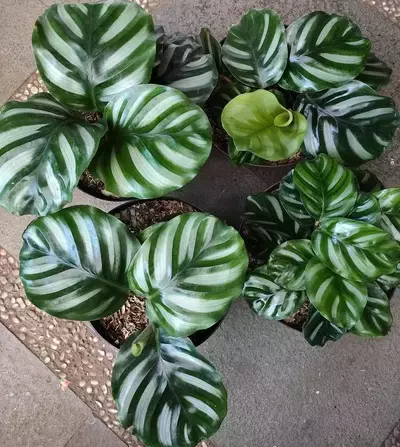
Calathea Fasciata will require repotting after one to two years. Take out the plant from the existing pot carefully to repot the plant. You need to moisten the soil by watering the plant a day or two before removal. Once the plant is out, please place it in a bigger pot at the same root depth as before. Fill the new pot with soil and water the plant deeply.
We recommend repotting your Calathea Fasciata in early spring before the growing season.

Calathea Fasciata Propagation
Propagation is to multiply one plants into several plants depending on the health and growth of your plant. You can propagate the Calathea Fasciata through the root division method only. Other propagation techniques like through seeds or cutting are not successful for Calathea Fasciata.
The most appropriate time to propagate your healthy Calathea is along with repotting when plant roots are already out of the pot.
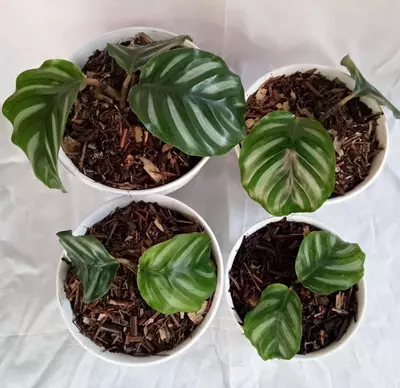
Following is a straightforward guide to propagating the Calathea Fasciata through root division.

Is Calathea Fasciata safe for pets?
No, the Calathea Fasciata is not toxic to animals or humans, which is a relief for pet owners or parents who have babies or pets who can accidentally chew on plant leaves.y chew on plant leaves.

Pests Diseases and common Queries
Pests
The pests that usually attack Calathea Fasciata are mealy bugs, spider mites, and aphids. Pests develop colonies on the underside of large leaves of the plant. If you notice an attack from the pests, first try to remove the infestation manually. You can clean the top and bottom surfaces of the leaves with a damp cloth. You can also use a 10% solution of rubbing alcohol for wiping leaves. Please ensure to prune and dispose of the highly infected parts of the plant.
If the problem persists, apply neem oil on the leaf as it is an excellent organic repellent for pests. You may use a houseplant pesticide if the situation demands.
Diseases
As Calathea Fasciata loves moist soil and humidity, it attracts fungal diseases. Wet or soggy soil will develop fungal attacks on roots and cause the rotting of roots. The disease symptoms are excessive yellowing of leaves near the roots, stem wilting, and the roots will turn back and feeling mushy. Root rot is a severe threat to plants, and you shall treat it immediately. For treatment, take the plant out of the pot, cut away the highly infected roots, and repot the plant in new soil after applying a fungicide. Please revisit your watering cycle to avoid the recurrence of the situation.

How big does a Calathea Fasciata get?
The Calathea Fasciata is a low-growing plant and, if grown under favorable conditions, will grow from 8 inches to 18 inches. However, in some cases, the plant can achieve height up to 25 inches.
Where should I place a Calathea plant in my house?
Calatheas thrive in medium to bright indirect light conditions. The perfect spot for your Calthea plant is east or north-facing window where the plant can receive filtered sunrays. If you are growing this plant outdoors, plant them in shady spots to prevent the burning of its foliage.

Final Words
The Calathea genus is widely cultivated and hybridized due to its uniquely pattered and variegated foliage that is aesthetically pleasing. Calathea Fasciata is a tropical plant that you can grow indoors and outdoors. Large, round, and thick glossy leaves with deep green prominent veins and purple underside make the plant center of attraction wherever placed. We hope this guide has covered all you need to know to grow and propagate this attractive plant. The key to keeping this plant happy and healthy is mimicking its natural habitat by providing bright indirect light, warm temperature and high humidity.












